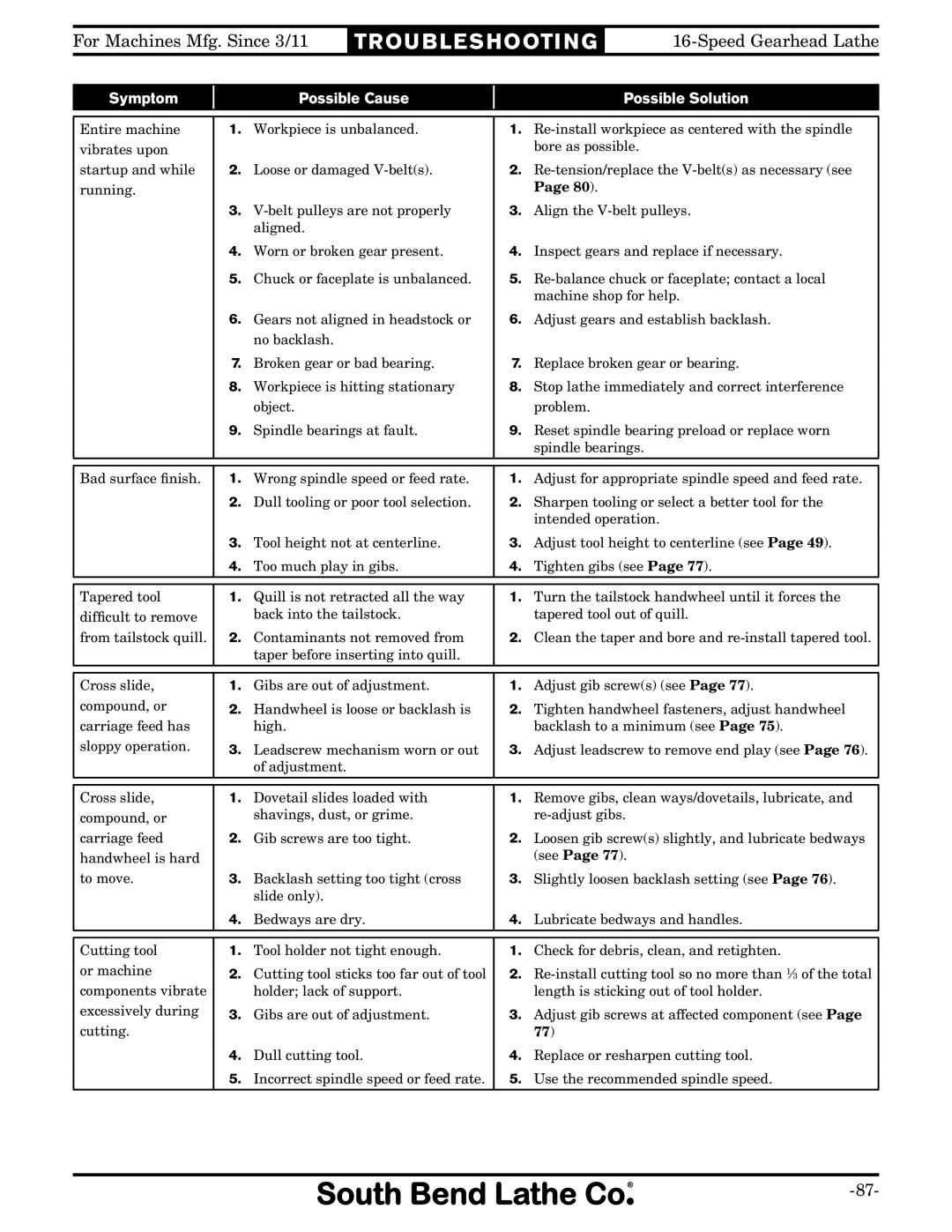
For Machines Mfg. Since 3/11 | TR O U B L E S H O OTI N G |
Symptom
Possible Cause
Possible Solution
Entire machine | 1. | Workpiece is unbalanced. | 1. | |
vibrates upon |
|
|
| bore as possible. |
startup and while | 2. | Loose or damaged | 2. | |
running. |
|
|
| Page 80). |
| 3. | 3. | Align the | |
|
| aligned. |
|
|
| 4. | Worn or broken gear present. | 4. | Inspect gears and replace if necessary. |
| 5. | Chuck or faceplate is unbalanced. | 5. | |
|
|
|
| machine shop for help. |
| 6. | Gears not aligned in headstock or | 6. | Adjust gears and establish backlash. |
|
| no backlash. |
|
|
| 7. | Broken gear or bad bearing. | 7. | Replace broken gear or bearing. |
| 8. | Workpiece is hitting stationary | 8. | Stop lathe immediately and correct interference |
|
| object. |
| problem. |
9.Spindle bearings at fault.9. Reset spindle bearing preload or replace worn spindle bearings.
Bad surface finish. | 1. | Wrong spindle speed or feed rate. | 1. | Adjust for appropriate spindle speed and feed rate. |
| 2. | Dull tooling or poor tool selection. | 2. | Sharpen tooling or select a better tool for the |
|
|
|
| intended operation. |
| 3. | Tool height not at centerline. | 3. | Adjust tool height to centerline (see Page 49). |
| 4. | Too much play in gibs. | 4. | Tighten gibs (see Page 77). |
|
|
|
|
|
|
|
|
|
|
Tapered tool | 1. | Quill is not retracted all the way | 1. | Turn the tailstock handwheel until it forces the |
difficult to remove |
| back into the tailstock. |
| tapered tool out of quill. |
from tailstock quill. | 2. | Contaminants not removed from | 2. | Clean the taper and bore and |
|
| taper before inserting into quill. |
|
|
|
|
|
|
|
|
|
|
|
|
Cross slide, | 1. | Gibs are out of adjustment. | 1. | Adjust gib screw(s) (see Page 77). |
compound, or | 2. | Handwheel is loose or backlash is | 2. | Tighten handwheel fasteners, adjust handwheel |
carriage feed has |
| high. |
| backlash to a minimum (see Page 75). |
sloppy operation. | 3. | Leadscrew mechanism worn or out | 3. | Adjust leadscrew to remove end play (see Page 76). |
|
| of adjustment. |
|
|
|
|
|
|
|
|
|
|
|
|
Cross slide, | 1. | Dovetail slides loaded with | 1. | Remove gibs, clean ways/dovetails, lubricate, and |
compound, or |
| shavings, dust, or grime. |
| |
carriage feed | 2. | Gib screws are too tight. | 2. | Loosen gib screw(s) slightly, and lubricate bedways |
handwheel is hard |
|
|
| (see Page 77). |
to move. | 3. | Backlash setting too tight (cross | 3. | Slightly loosen backlash setting (see Page 76). |
|
| slide only). |
|
|
| 4. | Bedways are dry. | 4. | Lubricate bedways and handles. |
|
|
|
|
|
|
|
|
|
|
Cutting tool | 1. | Tool holder not tight enough. | 1. | Check for debris, clean, and retighten. |
or machine | 2. | Cutting tool sticks too far out of tool | 2. | |
components vibrate |
| holder; lack of support. |
| length is sticking out of tool holder. |
excessively during | 3. | Gibs are out of adjustment. | 3. | Adjust gib screws at affected component (see Page |
cutting. |
|
|
| 77) |
| 4. | Dull cutting tool. | 4. | Replace or resharpen cutting tool. |
| 5. | Incorrect spindle speed or feed rate. | 5. | Use the recommended spindle speed. |
